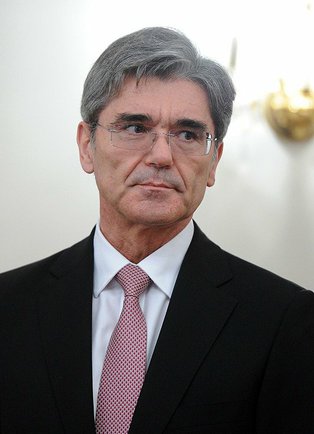
A board of directors is an executive committee that supervises the activities of a business, a nonprofit organization, or a government agency.
Corporate titles or business titles are given to corporate officers to show what duties and responsibilities they have in the organization. Such titles are used by publicly and privately held for-profit corporations, cooperatives, non-profit organizations, educational institutions, partnerships, and sole proprietorships that also confer corporate titles.
A vice president or vice-president, also director in British English, is an officer in government or business who is below the president in rank. It can also refer to executive vice presidents, signifying that the vice president is on the executive branch of the government, university or company. The name comes from the Latin term vice meaning "in place of" and typically serves as pro tempore to the president. In some countries, the vice president is called the deputy president. In everyday speech, the abbreviation VP is used.
A chief financial officer (CFO) is an officer of a company or organization who is assigned the primary responsibility for making decisions for the company for projects and its finances . The CFO thus has ultimate authority over the finance unit and is the chief financial spokesperson for the organization.
Corporate governance are mechanisms, processes and relations by which corporations are controlled and operated ("governed").
Senior management, executive management, or upper management is an occupation at the highest level of management of an organization, performed by individuals who have the day-to-day tasks of managing the organization, sometimes a company or a corporation.
A chief operating officer (COO) is an executive in charge of the daily operations of an organization. COOs are usually second-in-command immediately after the CEO, and reports directly to them and acts on their behalf in their absence.
A general manager (GM) is an executive who has overall responsibility for managing both the revenue and cost elements of a company's income statement, known as profit & loss (P&L) responsibility. A general manager usually oversees most or all of the firm's marketing and sales functions as well as the day-to-day operations of the business. Frequently, the general manager is responsible for effective planning, delegating, coordinating, staffing, organizing, and decision making to attain desirable profit making results for an organization.

Andrea Jung is a Canadian-American executive, non-profit leader, and prominent women's-issues supporter based in New York City. In April 2014, she became president and CEO of Grameen America, a nonprofit microfinance organization founded by Nobel Peace Prize winner, Muhammad Yunus. From 1999 until 2012, she served as the first female CEO and chairman of Avon Products, Inc., a multi-level marketing company. Jung was also the first woman to serve as Chairman of the Cosmetic, Toiletry & Fragrance Association, and Chairman of the World Federation of Direct Selling Associations.
A chief marketing officer (CMO), also called a global marketing officer or marketing director, or chief brand officer, is a corporate executive responsible for managing marketing activities in an organization. Whilst historically these titles may have signified a legal responsibility, for example at Companies House in the UK, the titles are less strict/formal in the 21st Century and allow companies to acknowledge the evolving and increasingly significant role that marketers can play in an organisation, not least because of the inherent character of successful marketers. The CMO leads brand management, marketing communications, market research, product marketing, distribution channel management, pricing, customer success, and customer service.
An audit committee is a committee of an organisation's board of directors which is responsible for oversight of the financial reporting process, selection of the independent auditor, and receipt of audit results both internal and external.
The chief risk officer (CRO), chief risk management officer (CRMO), or chief risk and compliance officer (CRCO) of a firm or corporation is the executive accountable for enabling the efficient and effective governance of significant risks, and related opportunities, to a business and its various segments. Risks are commonly categorized as strategic, reputational, operational, financial, or compliance-related. CROs are accountable to the Executive Committee and The Board for enabling the business to balance risk and reward. In more complex organizations, they are generally responsible for coordinating the organization's Enterprise Risk Management (ERM) approach. The CRO is responsible for assessing and mitigating significant competitive, regulatory, and technological threats to a firm's capital and earnings. The CRO roles and responsibilities vary depending on the size of the organization and industry. The CRO works to ensure that the firm is compliant with government regulations, such as Sarbanes–Oxley, and reviews factors that could negatively affect investments. Typically, the CRO is responsible for the firm's risk management operations, including managing, identifying, evaluating, reporting and overseeing the firm's risks externally and internally to the organization and works diligently with senior management such as chief executive officer and chief financial officer.

Joe Kaeser is a German manager who served as CEO of Siemens AG from 2013 to 2021.
A chief information security officer (CISO) is a senior-level executive within an organization responsible for establishing and maintaining the enterprise vision, strategy, and program to ensure information assets and technologies are adequately protected. The CISO directs staff in identifying, developing, implementing, and maintaining processes across the enterprise to reduce information and information technology (IT) risks. They respond to incidents, establish appropriate standards and controls, manage security technologies, and direct the establishment and implementation of policies and procedures. The CISO is also usually responsible for information-related compliance. The CISO is also responsible for protecting proprietary information and assets of the company, including the data of clients and consumers. CISO works with other executives to make sure the company is growing in a responsible and ethical manner.
The chief sustainability officer, sometimes known by other titles, is the corporate title of an executive position within a corporation that is in charge of the corporation's "environmental" programs. Several companies have created such environmental manager positions in the 21st century to formalize their commitment to the environment. The rise of the investor ESG movement and stakeholder capitalism, has increased the need for corporations to address sustainability and social issues across their value chain, and address growing needs of external stakeholders. Normally these responsibilities rest with the facility manager, who has provided cost effective resource and environmental control as part of the basic services necessary for the company to function. However, as sustainability initiatives have expanded beyond the facility — so has the importance of the position to what is now a C-level executive role. The position of CSO has not been standardized across industries and individual companies which leads it to take on differing roles depending on the organization. The position has also been challenged as symbolic, in that it does not actually have the effect of increasing sustainable practices.
A chief strategy officer (CSO) is an executive that usually reports to the CEO and has primary responsibility for strategy formulation and management, including developing the corporate vision and strategy, overseeing strategic planning, and leading strategic initiatives, including M&A, transformation, partnerships, and cost reduction. Some companies give the title of Chief Strategist or Chief Business Officer to its senior executives who are holding the top strategy role.
Chief business officer (CBO) is the position of the top operating executive of growing commercial companies or an academic/research institution. In the commercial space, CBO shows leadership in deal-making experience with a clear record of results and ultimate transactional responsibility. In higher education, the titles of vice president, associate dean, assistant dean, and director are also used for the role of the chief business officer.

The term director is a title given to the senior management staff of businesses and other large organizations.
Carsten Knobel is a German manager. Since January 1, 2020 he has been CEO of Henkel, a multinational consumer goods and industrial company listed in the German DAX index. Carsten Knobel is also a member of the supervisory board of Lufthansa.
Michelle Seitz is an American business executive and investor. She is the former chairman and chief executive officer of Russell Investments. Seitz is one of few women in the world who has led a global asset management firm. She is, according to Barron's, one of the "most influential women in U.S. finance". American Banker lists her as one of the "most powerful women in finance." Prior to her role at Russell Investments, she served on the board of William Blair & Company and as chief executive of William Blair Investment Management. In 2022, she left Russell Investments to launch an investment firm MeydenVest Partners.




